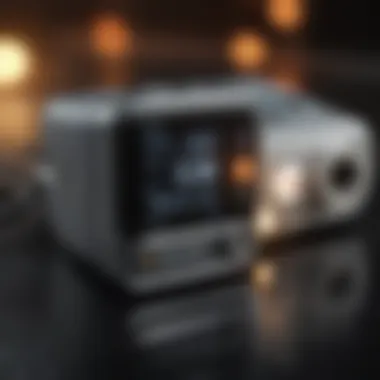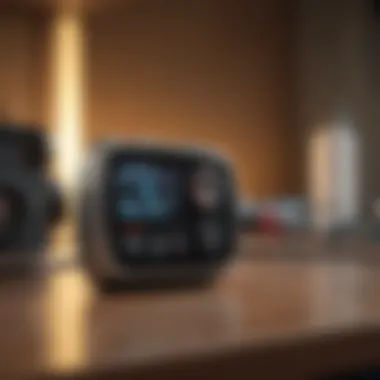Understanding Normal Readings for Oximeters


Intro
This article serves as a deep dive into the significance of oximeters and their normal readings. Oximeters are devices crucial for monitoring oxygen saturation levels in the blood. Given increasing health concerns, understanding how these readings function and what they imply becomes paramount. Oxygen saturation plays a role in various conditions, especially those impacting lung function.
In today’s world, both clinical and home settings utilize oximeters to monitor patients effectively. Yet, there remain common misunderstandings about what constitutes a normal reading. This narrative aims to elucidate these concepts, offering a cohesive understanding of how to interpret oximeter readings properly and their critical implications for health management.
Prelims to Oximeters
The significance of understanding oximeters cannot be overstated. These devices serve as vital tools in both clinical and home settings for monitoring an individual's oxygen saturation levels. Oxygen saturation, a critical indicator of respiratory health, provides insight into how effectively oxygen is being transported throughout the body via the bloodstream. This article will explore the mechanics of oximeters, focusing on their definitions, historical evolution, and the implications of their readings.
Definition of an Oximeter
An oximeter is a medical device, primarily used to measure the level of oxygen saturation in the blood. By utilizing light absorption properties of blood, it determines the percentage of hemoglobin that is saturated with oxygen. Devices can be found in various forms, including wearable pulse oximeters, typically clipped onto a fingertip, and larger, more complex units used in hospitals. Such ease of use allows for real-time monitoring, making it essential in emergency settings, as well as routine assessments of patients with respiratory conditions.
Historical Context
The journey of oximeters began in the late 1930s when early models emerged that used spectrophotometry to ascertain oxygen levels in blood. Over the decades, technological advancements have significantly transformed these devices. The development of pulse oximetry in the 1980s, for example, revolutionized the field by allowing for non-invasive measurement and instant results. These advancements have led to the widespread utilization of oximeters in diverse settings, ranging from operating rooms to home healthcare. As such, gaining an understanding of oximeters is crucial, especially in regard to their functionality and the reliability of the readings they provide.
Understanding Oxygen Saturation
Understanding oxygen saturation is pivotal in monitoring a person’s health. It provides insight into the efficiency of oxygen transport in the bloodstream, which directly correlates with respiratory and circulatory health. It is essential for both clinical settings and home-use scenarios where oximeters are employed. Being informed about oxygen saturation can help detect potential health issues before they escalate.
Oxygen saturation is not just a number; it reflects the balance between oxygen supply and demand within the body. Recognizing normal saturation levels helps professionals make better health decisions. Furthermore, it assists patients in understanding their conditions. Consistent monitoring can lead to early detection of problems like hypoxia, where oxygen levels drop dangerously low.
Also, knowing how oximeter readings can change based on physical activity or health status is crucial. Factors like altitude, respiratory rates, and overall cardiovascular health can all affect readings. Therefore, understanding oxygen saturation also involves understanding how various conditions and behaviors can influence these numbers.
How Oximeters Work
Understanding how oximeters work is crucial in appreciateing their role in monitoring oxygen saturation levels. Oximeters use light absorption principles and specific processes to provide accurate readings. This knowledge can help students, researchers, and healthcare professionals make informed decisions regarding patient care and health monitoring.
Principles of Light Absorption
The fundamental working principle of oximeters is based on the absorption of light by oxygenated and deoxygenated hemoglobin in the blood. When oximeters are placed on a thin part of the body, usually a fingertip or earlobe, they emit light at two different wavelengths. These wavelengths typically range in the red and infrared spectrum.
As the light passes through the blood vessels, some of the light is absorbed by the hemoglobin. Oxygenated hemoglobin absorbs different amounts of light compared to deoxygenated hemoglobin. By measuring how much light is not absorbed and has passed through the tissue, oximeters can calculate the ratio between these two forms of hemoglobin. This ratio is then used to derive the oxygen saturation level in the blood.
The accuracy and reliability of readings largely depend on the proper functional principles of light absorption.
Pulse Oximetry Process
The pulse oximetry process involves a series of steps to obtain oxygen saturation levels. First, the oximeter emits light and detects the amount of light that passes through the tissue. This occurs during a pulse cycle, capturing both the arterial and venous blood flows. The device continuously monitors heartbeats, which helps determine the pulsatile nature of arterial blood as opposed to the non-pulsatile venous blood.
- Emission of Light: The device emits red and infrared light.
- Light Passage: Light travels through the skin and blood vessels, interacting with hemoglobin.
- Detection: The oximeter measures how much light is absorbed.
- Calculating Saturation: The ratio of absorbed light is used to calculate the oxygen saturation levels.
- Displaying Results: Finally, the saturation is displayed on the device, typically as a percentage.
Oximeters may also display a pulse rate alongside the oxygen saturation level, providing healthcare professionals with an additional data point. Understanding these processes allows for better interpretation of readings and insight into a patient's respiratory status.
Factors Affecting Oximeter Readings
Understanding the factors that affect oximeter readings is crucial for accurate measurement and interpretation of oxygen saturation levels. These factors can be grouped into two main categories: patient factors and device factors. Both categories encompass elements that can influence the reliability and accuracy of the readings obtained from oximeters. Awareness of these factors will enhance the understanding of how to obtain the most accurate results, allowing users—whether in clinical settings or at home—to monitor health more effectively.


Patient Factors
Skin pigmentation
Skin pigmentation can significantly affect oximeter readings. Oximeters function by measuring the absorption of light through the skin. Darker skin tones may absorb light differently than lighter skin tones, which can lead to inaccurate readings. It is essential to recognize this variability, as it underscores the importance of selecting oximeters that account for such differences.
Moreover, this aspect addresses a broader issue regarding health equity. The variations in readings for individuals with different skin colors highlight the need for careful calibration of oximeters in diverse populations.
Nail polish
Another relevant patient factor is the presence of nail polish. Certain colors of nail polish, particularly darker shades or metallic finishes, can obstruct the light emitted by oximeters. This obstruction can lead to falsely low oxygen saturation readings. Therefore, it is advisable for users to remove nail polish before taking measurements to ensure accuracy.
The importance of this factor emphasizes how seemingly minor details can impact readings significantly. Educating patients about proper preparation, such as removing nail polish, increases the reliability of the results.
Peripheral circulation
Peripheral circulation plays a notable role as well. Individuals with poor circulation may receive inconsistent readings from oximeters. Factors such as cold extremities, blood flow issues, or even certain medical conditions can lead to diminished blood flow to the fingers or earlobes, where oximeters are typically placed.
This can result in unreliable oxygen saturation measurements. It is thus vital for users to be aware of their circulation status when using an oximeter. If there are concerns about peripheral circulation, alternative sites for measurement should be considered.
Device Factors
Calibration issues
Calibration is a critical component of the reliability of oximeter readings. Over time, devices may drift from their calibrated settings, leading to inaccuracies in the measurements. Regular calibration checks and adherence to manufacturer guidelines are essential to maintain the accuracy of oximeters.
Through appropriate calibration, users ensure that their devices provide readings that reflect true physiological states. Calibration issues highlight the importance of device maintenance in achieving reliable monitoring.
Quality of the device
The overall quality of an oximeter also fundamentally impacts readings. Not all devices are manufactured to the same standards. High-quality devices are typically more accurate and provide more consistent readings compared to lower-quality alternatives.
Investing in a reputable brand is advisable for anyone considering regular use of oximeters. Understanding the quality of the device can prevent individuals from relying on potentially inaccurate information, which could have significant health implications.
Interpreting Oximeter Readings
Interpreting oximeter readings is a vital skill for anyone involved in health management, whether in clinical settings or at home. By understanding how to accurately read and assess these values, healthcare professionals and individuals can better manage respiratory and cardiovascular health. Oxygen saturation levels, which these devices measure, are critical indicators of how effectively the body is receiving oxygen. Low or abnormal levels might suggest underlying health issues that require immediate attention. Therefore, a clear grasp of both normal and abnormal readings is paramount to safeguard health and promote well-being.
Identifying Normal Readings
Typical ranges
The typical range for oxygen saturation is generally between 95% to 100%. This range reflects the healthy functioning of the lungs and cardiovascular system. Understanding this range helps individuals discern between normal and concerning levels of oxygen saturation. Health professionals often rely on this standard when evaluating patients in various contexts. The primary characteristic is its role as a benchmark for optimal oxygen delivery within the body, which directly supports crucial bodily functions. This makes it an essential topic in understanding oximeter readings.
In addition, readings consistently below 95% may signify issues that require further investigation. One important feature of these typical ranges is its consistency across diverse populations, although slight variations may exist based on individual health status, age, or activity level. Acknowledging this can help tailor individual assessments and interventions.
Abnormal indications
Abnormal indications refer to oxygen saturation levels outside the typical range. Levels below 90% are especially concerning and may imply potential health risks. Understanding these indicators is crucial for effective health monitoring. The predominant feature of abnormal readings is that they signal possible respiratory or cardiovascular distress, prompting further medical evaluation.


Such indications prompt immediate action, which emphasizes the importance of having accurate knowledge of how to interpret these readings. They serve as an alarm, indicating that the body may not be receiving adequate oxygen. This characteristic of abnormal readings is beneficial for proactive health management; being aware of what constitutes a 'red flag' can enable timely interventions.
In addition, abnormal readings can result from various factors, such as altitude, existing health conditions, or even technical errors with the oximeter itself. Therefore, users must be aware of possible confounding variables when interpreting these readings.
Implications of Low Saturation Levels
Low saturation levels carry significant implications for health. Oxygen saturation below 90% may lead to symptoms such as confusion, restlessness, or difficulty breathing. When the body does not get enough oxygen, it can have serious consequences, including organ damage or respiratory failure if not addressed promptly.
Understanding these implications allows individuals to take responsibility for their health by recognizing when to seek medical advice. It emphasizes the importance of ongoing monitoring, especially for vulnerable populations such as those with chronic lung conditions or heart diseases. Regular assessments can lead to earlier detection of problems, thus facilitating timely and effective interventions.
In summary, accurate interpretation of oximeter readings is essential. By being knowledgeable about normal and abnormal readings and understanding the implications of low saturation levels, both healthcare providers and individuals can enhance health monitoring. This can ultimately lead to better health outcomes.
Common Misconceptions about Oximeters
Understanding the misconceptions surrounding oximeters is crucial for anyone involved in health monitoring. Misunderstandings can lead to incorrect usage and potential misinterpretation of oxygen saturation levels. This can affect not only individual health management but also medical decision-making in clinical settings.
The following sections address key areas where misconceptions often arise. By clarifying these points, we can foster a better understanding of how oximeters function and their limitations.
Understanding Accuracy Myths
A common myth about oximeters is that they provide infallible readings. In reality, several factors can impact the accuracy of these devices. Some users assume that the oximeter reading is always a precise reflection of oxygen levels in the blood, which is not the case.
Several conditions can lead to erroneous readings:
- Poor circulation: Blood flow affects measurement accuracy. Conditions like cold extremities or peripheral artery disease can yield misleading results.
- Skin pigmentation: Darker skin tones may lead to variations in accuracy, depending on the device's calibration.
- Nail polish or artificial nails: Any obstruction covering the fingertip can interfere with the light absorption process of pulse oximetry.
It's essential to recognize these factors when interpreting results. Users need to consider the context around the reading, not just the number displayed on the screen. Regular calibration and maintenance of the oximeter are also critical to maintaining accuracy.
The Role of Oximeters in Health Monitoring
Oximeters are integral tools for monitoring oxygen saturation levels, especially in clinical environments. Their primary role is to help healthcare providers assess a patient's respiratory status quickly. However, many individuals may not fully understand their significant benefits.
Here are some points to consider regarding the role of oximeters in health monitoring:
- Quick assessment: Oximeters provide immediate readings, enabling rapid decision-making in emergencies.
- Non-invasive process: The portability and ease of use make them practical for both at-home and clinical applications.
- Chronic condition management: For patients with respiratory issues like COPD or asthma, oximeters help track how well they manage their condition over time.
However, users should remember that while oximeters are valuable, they do not replace comprehensive medical evaluations. For accurate health assessments, readings should be contextualized with other clinical signs and symptoms. Regular consultations with healthcare providers remain essential to well-informed health management.
Applications of Oximeters
The application of oximeters extends across various settings, significantly influencing patient care and individual health management. Understanding how these devices function in both clinical and home environments is essential for maximizing their benefits. Oximeters have become increasingly important for monitoring oxygen saturation, providing a useful tool for both healthcare professionals and individuals managing their health conditions.
Clinical Use in Hospitals
In clinical settings, oximeters play a critical role in patient monitoring. Hospitals use these devices to assess a patient's respiratory function, especially in cases involving acute respiratory distress, chronic obstructive pulmonary disease (COPD), or during anesthesia. The real-time data provided by pulse oximetry aids healthcare providers in making timely decisions about oxygen therapy or adjustments needed for mechanical ventilation.
A few key points regarding clinical use include:
- Immediate Feedback: Oximeters provide instantaneous readings, allowing for rapid response to changes in a patient’s condition. This immediacy is vital in emergency situations.
- Continuous Monitoring: In critical care units, continuous oximeter readings help in tracking patient responses to treatment and interventions.
- Guiding Treatment Decisions: Oximetry results guide healthcare providers in establishing the adequacy of oxygen therapy, tailoring interventions based on real-time data.


Using oximeters effectively in hospitals necessitates staff training to manage device calibration, placement, and understanding the readings accurately. This knowledge is crucial, as inaccurate readings can lead to misinterpretation and inappropriate clinical responses.
Home Use and Monitoring
Oximeters are also increasingly utilized in home healthcare settings. This usage surge is attributed to the rise in chronic respiratory diseases and the need for continuous health monitoring outside of clinical environments. Home monitors empower individuals to track their oxygen saturation levels, thus playing a pivotal role in managing health proactively.
Benefits of using oximeters at home include:
- Accessibility: Home oximeters provide patients with the autonomy to monitor their conditions without needing frequent doctor visits.
- Empowerment: Knowing their oxygen levels encourages individuals to take actions, such as contacting healthcare providers if readings fall outside normal ranges.
- Improved Quality of Life: For patients with chronic conditions, regular monitoring can lead to better symptom management and fewer emergency situations.
It’s important for users to familiarize themselves with their devices, ensuring proper technique for placement and understanding how to interpret the readings. Following guidelines allows individuals to leverage these devices effectively, ensuring better health outcomes.
This knowledge encourages informed decision-making regarding health, especially for those with chronic conditions.
In summary, the applications of oximeters in both clinical and home settings underline their essential role in oxygen saturation monitoring. Understanding these applications is vital for students, researchers, educators, and professionals engaging in health management.
Best Practices for Oximeter Use
The effective usage of oximeters plays a crucial role in ensuring accurate blood oxygen level readings. Adhering to best practices enhances the reliability of results, which is vital for both clinical and home monitoring. These practices not only promote better health management but also help in preventing misinterpretations that could lead to unnecessary anxiety or incorrect treatment decisions. Some key aspects to consider include understanding proper placement techniques and regular calibration and maintenance of the device.
Proper Placement Techniques
Correct placement of the oximeter is critical. This involves ensuring that the sensor is attached firmly to the fingertip, toe, or earlobe. The chosen site should be clean and well-circulated. Here are specific steps to follow:
- Select an appropriate site: Choose a finger that is free of nail polish and has good circulation. The index or middle finger is often suitable.
- Ensure a comfortable fit: Place the oximeter on the site without excessive pressure. The device must not be too tight, as this can restrict blood flow.
- Keep the hand still: Movement can cause inaccurate readings. Encourage the individual to keep their hand relaxed and stationary during the measurement.
- Wait for the reading to stabilize: Allow adequate time for the oximeter to obtain a stable reading. This usually takes a few seconds but can vary by device.
Adhering to these techniques helps in achieving the most precise readings. It limits the impact of external factors that may distort the results, ensuring a reliable assessment of oxygen saturation levels.
Calibration and Maintenance
Regular calibration is vital to maintaining the accuracy of oximeter readings. Oximeters must be calibrated according to the manufacturer's instructions to function optimally. Lack of calibration can result in drifted readings, leading to misdiagnosis or inappropriate medical responses.
- Regular checks: Perform regular checks to evaluate the accuracy of the device. This can include comparing with known standards or reference devices.
- Follow manufacturer guidelines: Each device comes with specific calibration needs. Consulting the user manual helps in understanding a device’s requirements.
- Proper cleaning: Keeping the sensor clean is essential. Use a soft cloth to wipe the oximeter, and avoid harsh chemicals that could damage the device.
- Storage: Store oximeters in a cool, dry place, avoiding direct sunlight or excessive moisture, which may affect their functionality.
"Regular calibration and maintenance of oximeters are critical to ensuring their accuracy, which directly impacts patient care and monitoring."
These best practices will not only enhance the lifespan of the oximeter but also ensure that health monitoring is efficient and effective. Following these guidelines mitigates the risk of inaccuracies while maximizing health insights from this essential device.
Future Developments in Oximetry
The field of oximetry is undergoing rapid evolution due to ongoing innovations and advancements. Understanding future developments is crucial for several reasons. Firstly, these advancements could improve the accuracy, reliability, and accessibility of oximeters. Secondly, better devices have the potential to influence patient outcomes positively, particularly in critical care and home monitoring scenarios. Lastly, as oximeters become integral to telehealth, they can support remote patient management and contribute to more comprehensive healthcare delivery.
Technological Innovations
Technological innovations in oximetry focus on enhancing device functionality and measurement performance. Several new technologies are emerging, including:
- Wearable devices: These are designed for continuous monitoring, allowing real-time tracking of oxygen saturation levels. They provide comfort and convenience, particularly for patients with chronic respiratory conditions.
- Smartphone integration: With advancements in mobile technology, certain applications now allow smartphones to function as oximeters. This increases accessibility, making it easier for individuals to monitor their oxygen saturation without the need for specialized equipment.
- Advanced sensors: New sensor technologies improve accuracy and reduce the influence of external factors such as skin color and temperature variations. This addresses a common issue with traditional oximeters and broadens their reliability across diverse populations.
These technological innovations not only enhance the effectiveness of oxygen measurement but also ensure that monitoring can occur in various settings, thus improving patient care.
Integration with Telehealth
The integration of oximeters with telehealth services signifies a pivotal shift in healthcare delivery. By enabling patients to monitor their oxygen saturation at home, healthcare providers can manage conditions remotely more effectively. This is especially relevant in the wake of increased telemedicine adoption due to the global health crisis. Key advantages of this integration include:
- Improved patient engagement: Patients become more responsible for their health management, contributing to better health outcomes.
- Timely interventions: Real-time data allows healthcare providers to make swift decisions based on patients' oxygen levels, potentially preventing emergencies or hospitalizations.
- Broader reach: Telehealth expands access to healthcare professionals, particularly in rural or underserved areas, where traditional healthcare facilities may be limited.



